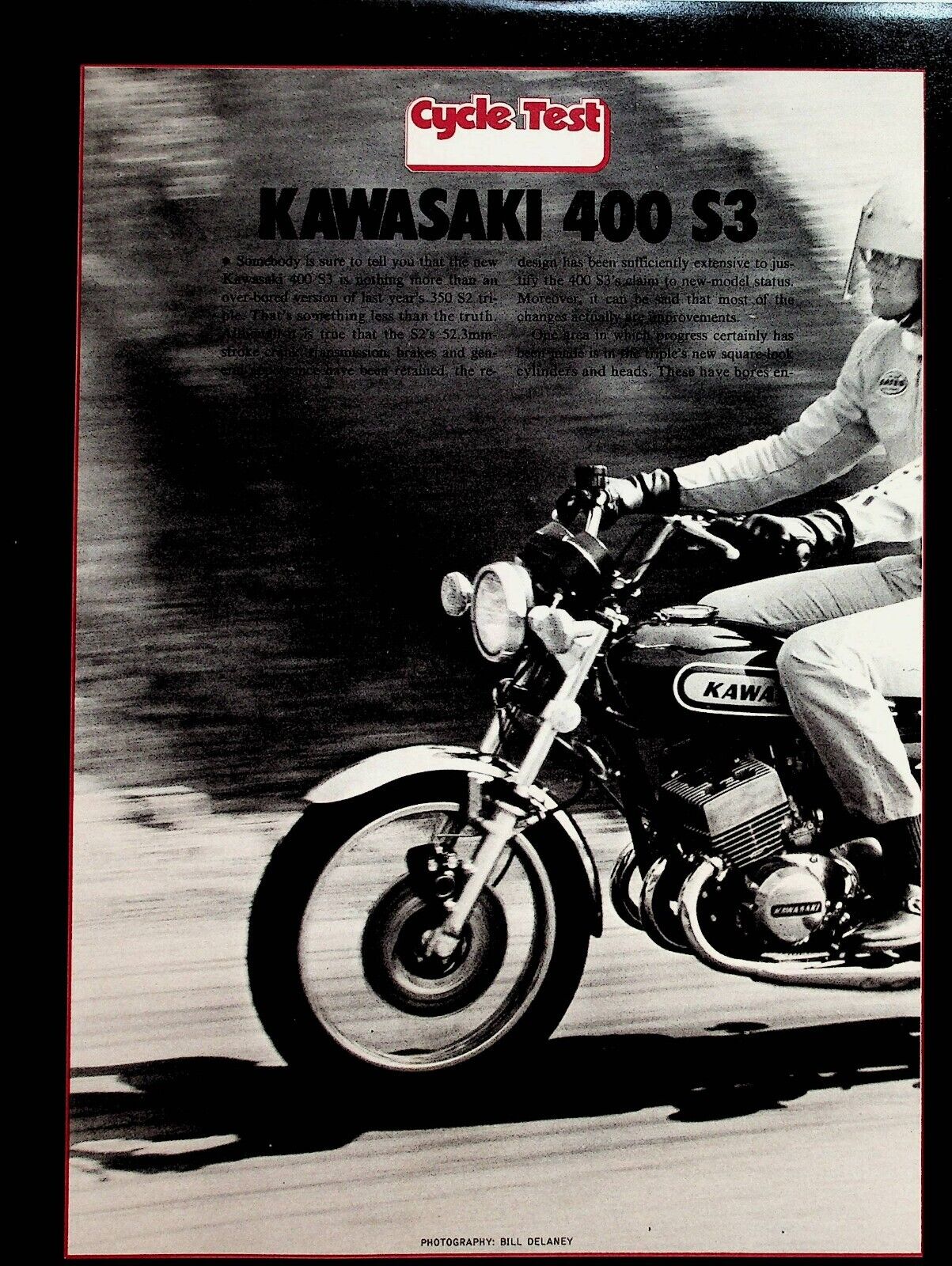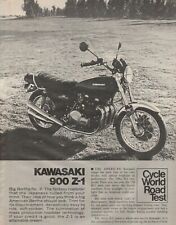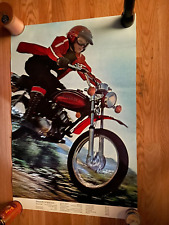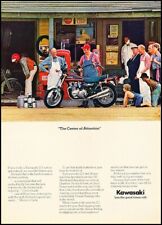When you click on links to various merchants on this site and make a purchase, this can result in this site earning a commission. Affiliate programs and affiliations include, but are not limited to, the eBay Partner Network.
Yes we combine shipping for multiple purchases.Add multiple items to your cart and the combined shipping total will automatically be calculated.
1974 Kawasaki 400 S3 - 5-Page Vintage Motorcycle Road Test Article
Original, vintage magazine advertisement / articlePage Size: Approx. 8" x 11" (21 cm x 28 cm)Condition: Good
...When you've cleaned and set the points, you've done a job.Oil injection pumps are the sine qua non of modern two-strokes.Squared cylinder and head assemblies distinguish the 400; appearance reflects that of Yamaha RD 350.larged to 57mm (from the S2’s 53mm) andare fitted with 26mm carburetors—up 2mmfrom those on the 350. Both of these changeshave added tone to the Kawasaki’s already-impressive muscle, and a lot more class to itsappearance: the styling is all right; most ofthe improvement is in terms of apparentquality. At one time Kawasaki’s cylinderswere cobby enough to have been cast in box-es of used kitty-litter, and we are delightedto find all the old nubs and warts missingfrom those on the 400.Some of the performance gain inherent inthe displacement and carburetion revisionsprobably is offset to some extent by the low-ered compression ratio the engine gets withits new cylinderheads. The old 350 triplehad a compression ratio of 7.3 to 1; in the400 this has been dropped to 6.5 to 1. Per-haps the reduction is intended to ease thethermal stresses on the engine, and to makeit more tolerant of fuel quality. But it isequally possible that this particular changeis directly linked to the redesigned kick-startmechanism—which has resulted in a drasti-cally different over all starter drive ratioThe S2’s kick-starter drive passed throughthe gearbox and clutch, with gearing thatprovided an extremely low effort level at thepedal and a correspondingly low number ofcrankshaft turns per kick. The 400’s starterdrive still runs through the gearbox, but nowthe ratio raises the leg-muscle requirementconsiderably—and translates a healthy kickinto a whirling frenzy at the crank.No change has been made in the transmis-sion ratios and that’s good because none wasneeded. Like the 350 from which it is de-rived, Kawasaki’s 400 pulls well over a fairlybroad rpm range but does fall flat below itsworking powerband. So it needs a goodgearbox . . . and it has one. We think thatthis new model has a slightly nicer gear se-lector mechanism than that in the 350, andwe definitely like the relocation of neutral,which now is between first and second gearsinstead of being a notch past low gear. Andthe limit for strain-free cruising has beenbumped upward a notch by switching fromthe 35O’s 43-tooth rear wheel sprocket toone having 41 teeth.This alteration in the overall final driveratio, from 6.56 to 6.25 to 1 in fifth gear,assumes special importance in light of thenew rubber-bushed engine mountings. Withrubber cushions inserted between engine andframe very little vibration gets through tothe seat, pegs and handlebars al moderateengine speeds. Unfortunately there exists apoint beyond which the combination of vi-bration and reflected torque create loads therubber bushings cannot resist. Then theslight freedom of movement provided by thebushings actually begins to amplify enginevibration. You’ll feel this in the handlebarsquite strongly just as the speedometer needlesweeps past the 70 mph mark, and the effectis present in more subdued form under hardacceleration in the lower gears. Most peoplewill have the good sense to keep their cruis-ing speed below 70 mph and won’t noticethe abrupt increase in vibration level, but ifthe 400 had the 35O’s gearing the shakingwould commence at a lower speed and we’dall learn to hate it. As things stand the rub-ber bushings do help and the Kawasaki 400S3 will impress nearly everyone as being avery smooth-running motorcycle.Along with the revised engine mountingsystem, the 400 gets a new frame—or atleast a new frame part number. Frankly, wecan’t see any difference between it and the35O’s frame. It may be that the difference isconfined to minor variations in brackets. Or,perhaps Kawasaki uses thicker-wall tubingin fabricating the frame for the S3 as ameans of regaining some of the rigidity lostin rubber-mounting the engine—which nolonger can serve as a structural member.Whatever Kawasaki may have done withthe frame, the steering head angle remains asit was on the 350, and trail is increased from4.3 to 4.4 inches only because the 400’s 3.25-section front tire is slightly taller than theS2’s 3.00-18. But with the “soft” enginemountings the S3 chassis has been givensofter springs, and under most road condi-tions the bike does nicely in getting past thehumps and hollows without jolting its rider.The suspension’s single comfort-relatedshortcoming is that it has that all-too-com-mon inability to deal with sharp discontinui-ties, however small, in the road surface. Theseams in poured-concrete roads especiallyappear to totally overwhelm the forks.The S3’s forks also are overwhelmed bythe effects of maximum-effort braking. Wehave come to expect that disc brakes willperform minor braking miracles, but the oneon the Kawasaki 400’s front wheel is an ex-ceptionally good example of the type and itdumps an enormous weight-transfer load onthe forks. The relationship between pressureapplied at the lever and retarding action atthe disc is so precise that you can get the tireworking right at the point of lockup withoutworrying about inadvertently going past thatpoint. Only one difficulty intrudes: the brakeis better than the forks and stronger than thefork springs, so that in a panic-level stop theforks compress enough to use up nearly alltheir travel and then the lack of dampinglets the front wheel hop, banging the forksright against the stops. At the limit you getthe sound of forks clanging, and a pullulat-ing squall from the front tire that evokes im-ages of a basso profundo toy poodle in hot,noisy and glorious pursuit.After you’ve made a few of those full-ef-fort stops you may discover, as did our test-ers, that the front disc has begun to squeal.And that’s the only distress signal we gotduring a session of brake brutalizing.There’s a tendency for the rear brake’s ped-al-travel to lengthen somewhat as the drumgels hot but this seems to be no more than atemporary condition and never seriously im-pairs the triple’s ability to stop.Handling is a category in which thosecomfort-oriented spring rates are very mucha mixed blessing. Though the 350 S2 wasone of the best handling machines we testedin 1972, it was a bit chattery in choppyturns. The S3’s softer springs have banishedthat tendency to chatter—at a price. You getslightly better tire adhesion with the 400,but the new springs let it sag lower in re-sponse to cornering loads and it loses someof the S2’s generous cornering clearance.Then too, the Kawasaki's dampers are a tri-fle limp, allowing the bike to surge up anddown on its springs. Consequently the han-dling becomes distinctly rubbery and thesteering imprecise when you get into a situa-tion that calls for a lot of improvising in themiddle of a comer. Actually, the worst thingabout the 400’s overall handling characteris-tics is that they do not inspire a sportingrider’s confidence. Under nearly all condi-tions the S3 behaves very well and its ride-quality is better than that of the 350. Butwhen you begin hustling it lets you knowthat it is not totally forbearing; that ifpressed beyond its limit it might turn uponyou with tooth and claw.Riding comfort is made up of more thansoft springs. Some bikes ride well enoughbut simply do not feel right; others feel finefor the first five minutes in the saddle andthen begin pinching nerves and numbingmuscles all over one's body. The Kawasakifeels right all the way, with the kind of nice,natural placement of pegs and bars thatwears very well on a long trip. Some back-sides may be too wide for the seat, which is alittle narrow, but what the seat lacks inwidth it compensates with length and pad-ding. A wider seat probably wouldn't be anymore comfortable for most riders, andwould look funny on this narrow motorcy-...
17347






